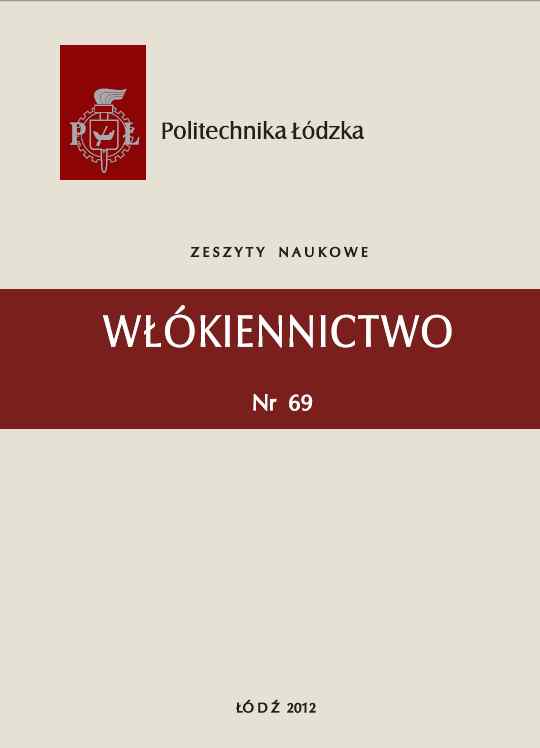Abstrakt
W pracy podjęto rozważania nad kształtowaniem struktury przędz komponentowych formowanych techniką łączenia pneumatycznego, w których składzie znajduja sie dwie przedze składowe – przędza z włókien ciągłych oraz przędza z włókien odcinkowych. Dotychczas proces sczepiania pneumatycznego był wykorzystywany w obróbce i łączeniu przędz z włókien ciagłych. Część doświadczalna obejmowała wykonanie 45 wariantów przędz komponentowych w trzech układach asortymentowych, zawierających przędzę składowe bawełniane pochodzące z trzech różnych systemów przędzenia (cienkoprzędny, średnioprzedny, rotorowy), połączone z gładka przedza poliestrowa z włókien ciagłych. Wyniki badań metrologicznych uzyskanych wariantów przędz komponentowych przeanalizowano w funkcji parametrów technologicznych procesu łączenia. Dla wybranych wariantów przędz wykonano rzeczywiste próbki dzianin oraz wirtualne symulacje tkanin i dzianin w oparciu o optyczne badania struktury przedz. Wyniki badań zostały poddane ocenie statystycznej. Efektem pracy jest obraz kształtowania struktury i własciwości unikatowych przędz komponentowych, formowanych techniką sczepiania pneumatycznego w zależnosci od przyjetego układu przedz składowych oraz ustalonych wartości parametrów procesu ich łączenia.
Bibliografia
Jabłonski W., Jackowski T.: Nowoczesne systemy przędzenia bazą innowacyjności w procesach wytwarzania przędz, Wyd. Beskidzki Instytut Tekstylny, Bielsko-Biała 2001.
Ankudowicz W., Dopierała H.: Sczepianie pneumatyczne w wytwarzaniu przędz filamentowo-staplowych, Przegląd Włókienniczy nr 1/2005.
Sachova N., Usenko V.: Opracowanie technologii dwuskładnikowych przędz teksturowanych na jednoprocesowych maszynach różnego typu, Przegląd Włókienniczy nr 7/1985.
Priemsch W., Jansen P.-B.: State–of–the–Art Air Interlacing Technology for Filament Yarns, Journal of Industrial Textiles, Vol. 34, No. 3/2005.
Engelhart A.: SAURER RAPORT „Fiber Consumption Surged in 2004“, International Fiber Journal No. 6/2005.
Schwartz E., Lacher L. (Heberlein Fiber Technology Inc.): Air covering – a process with great potential, Presentation during the Elasthan Colloquium, Denkendorf, Germany 2001.
Bosch F. (Heberlein Fiber Technology Inc.): Polyester Micro and Super Micro Filament Yarns – a Megatrend, Asian Textile Business, November 2005.
Scherpt H.-D., Marc A. Zenses.: Advanced Air Jets to Meet Higher Performance Yarn Reguirements, International Fiber Journal, February 2004.
Weinsdoerfer H.: Improved Consistency in Flat Yarn Interlacing, International Fiber Journal, December 2001.
Scherpt H.-D., Mack A., Marc A. Zenses.: Interlacing technology for the manufacturing of BCF carpet yarns, Man Made Fiber, Year Book 2006.
Muller-Probandt S.: Manufacturing process of atmofil DSE yarns, Man Made Fiber, Year Book 2005.
Kryteria doboru parametrów procesu sczepiania przy zastosowaniu przedz poliuretanowych, E. Mielicka, Praca doktorska, Politechnika Łódzka 1999.
Pneumatyczny sposób tworzenia przędz łączonych staplowo-filamentowych, projekt badawczy nr 4T08E08224; 4.2003-12.2004, kierownik: W. Ankudowicz (Instytut Włókiennictwa).
Opracowanie oraz optymalizacja nowej generacji dysz pneumatycznych do łączenia przędz staplowych i staplowo-filamentowych, projekt badawczy nr 3T08E03630; 07.2006-06.2008, kierownik: W. Ankudowicz, H. Dopierała (Instytut Włókiennictwa).
Kształtowanie struktury i właściwości wybranych przędz komponentowych łączonych pneumatycznie, P. Swaczyna, Praca doktorska Politechnika Łódzka 2012.

